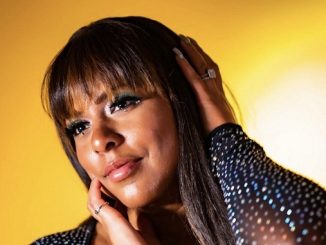Looking for more ways to explore Toronto? As locals, we are constantly rediscovering, reeducating and even rethinking what we are all about. We’ve recently spent a few days with Tourism Toronto to experience Indigenous arts & culture (and food!) in, and around, our city. Here are some ideas to get you started…
WHERE TO EAT:
NishDish Marketeria and Catering: 690 Bloor Street West. Offers traditional Anishnawbe (Nish) food. Over the last twelve years NishDish has grown as a catering business and recently opened up a casual storefront for quick bites from their short menu based on what’s cooking up in the catering kitchen that day. They are the First Nations Owned and Operated Food Emporium specializing in our Native cuisine and culture in Toronto.
Pow Wow Cafe: 213 Augusta Avenue, Kensington Market. Ojibway Chef Shawn Adler elevates Indigenous cuisine with his own spin on traditions. Locals flock there for his “Indian Tacos” made with Bannock. Duck Bacon is a delicious and a brunch favourite.
Bannock: 401 Queen Street West. Located at the flagship Hudson’s Bay store on Queen has a knack for creating an upscale atmosphere featuring Canadian comfort food. The restaurant features items that have lightly indigenous inspired dishes, but include a wide selection of traditionally Canadian eats so patrons are not limited in their choice.
Kūkŭm Kitchen: Chef Joseph Shawana was raised on the Wiikwemkoong Unceded Reserve located on Manitoulin Island on Lake Huron. As a child he played games while foraging for nature’s ingredients which has made an impact on his “whole ingredient” philosophy. We had recently learned they are relocating to a bigger space but in the meantime, catering is still available. Stay tuned!
Escape the City Canoe Paddle & Dining Adventure with Culinary Adventure Company: A breathtaking and leisurely way to wind down a summer’s day. Paddle across Toronto’s Harbour in a Heritage Voyageur Canoe, a replica used by early Canadian settlers while listening to stories of the city’s history and geography. Once you’re docked at the Toronto Islands, the crew will create a meal using wild-foraged ingredients, local meats, fish, and handmade breads and locally made desserts.
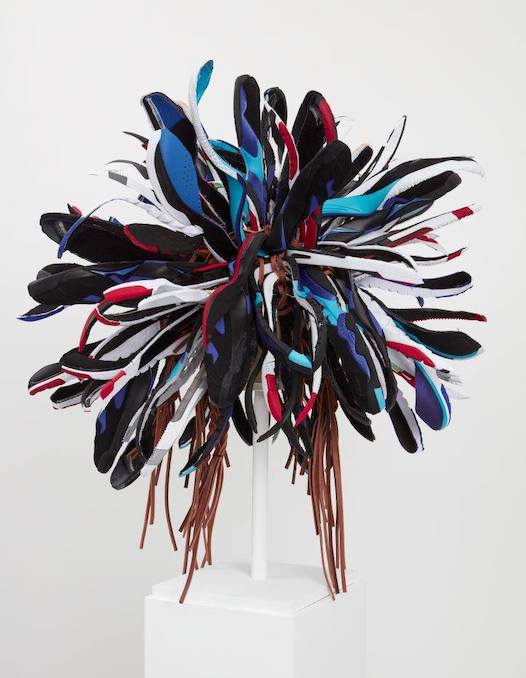
WHERE TO SEE MORE ART:
Art Gallery of Ontario: The gallery’s Inuit collection features more than 80 works by Inuit, Indigenous, and Canadian artists. In recognition that the AGO is located on Mississauga Anishinaabe territory, all texts in the McLean Centre are presented in Anishnaabemowin, English, and French. The Inuit collection also includes texts in Inuktitut, along with English and French. Not to be missed is the current feature exhibition Brian Jungen’s Friendship Centre (until August 25). This internationally acclaimed artist is known for his work created with consumer products – reassembling them to create new objects. Included in this exhibition is his recent Warrior sculpture series made with Air Jordans and presented as various Indigenous Headdresses. The exhibition features sculptures, paintings, drawings, and installation work that spans the artist’s career.
Royal Ontario Museum First Peoples Gallery: Located on the main floor of the Hilary and Galen Weston Wing, the Daphne Cockwell Gallery dedicated to First Peoples art & culture, features more than one thousand works of art and cultural heritage. Originally created in 2005 with the input of Indigenous advisors across Canada, this permanent gallery explores aspects of Indigenous cultures through collections housed at the ROM.
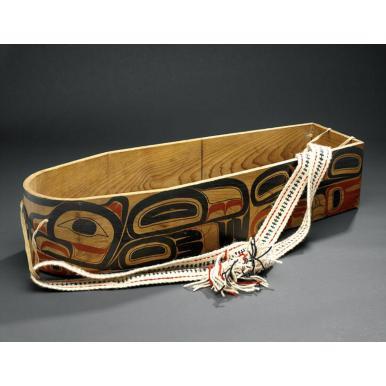
Galleria Indigena: Distillery District. Founded in Stratford, Ontario in the early 70’s, its galleries specialize in carefully chosen works in a variety of mediums from renowned artists: Inuit and Iroquois, Anishinabek, North Pacific Coast, Cree and Iroquois First Nations.
Native Earth Performing Arts: 250- 585 Dundas Street East. Canada’s oldest professional Indigenous performing arts company dedicated to developing, producing and presenting artistic expressions of the Indigenous experience in Canada.
The Cedar Basket Gift Shop at the Native Canadian Centre of Toronto: 16 Spadina Road. Toronto’s only Indigenous owned and operated store. In the heart of the city’s Annex area, browse the wide selection of First Nations, Métis and Inuit handcrafted jewelry, carvings, basketry, beadwork, moccasins, and original art. The Native Canadian Centre of Toronto also offers workshops and services based on Indigenous cultural traditions and teachings.
Craft Ontario Shop: 1106 Queen Street West. Craft Ontario has supported Canadian artisans of all types since 1931 through online and instore sales of their works. As one of the first establishments to represent Inuit and Native art in Toronto, the art shop continues to support and be supported by the rich history and culture of Canada’s Indigenous people. Their shop represents Indigenous artists from across Canada as well as remote Northern regions.
Pacha Indigenous Art Collection: 614 Bloor Street West. An Indigenous family-run art gallery and shop. Pacha (meaning “earth” in Kichwa) aims to showcase the best of Indigenous arts and crafts. PACHA’s items are mostly crafted by local Indigenous artists and often tell a story about the area in which they were created or inspired by. PACHA also hosts indigenous music jams, discussions and special events.
Ravenspirit: 16 Wellesley Street West. Offers the finest collection of native Canadian Aboriginal art & culture though their collection of authentic pieces since 1979. Not only a gallery, Ravenspirit offers a wide selection of original pieces from West Coast natives to the Woodland, Six Nations tribes and Inuit native nations. Their goal is to present the artistic craftsmanship of these traditional art forms to collectors.
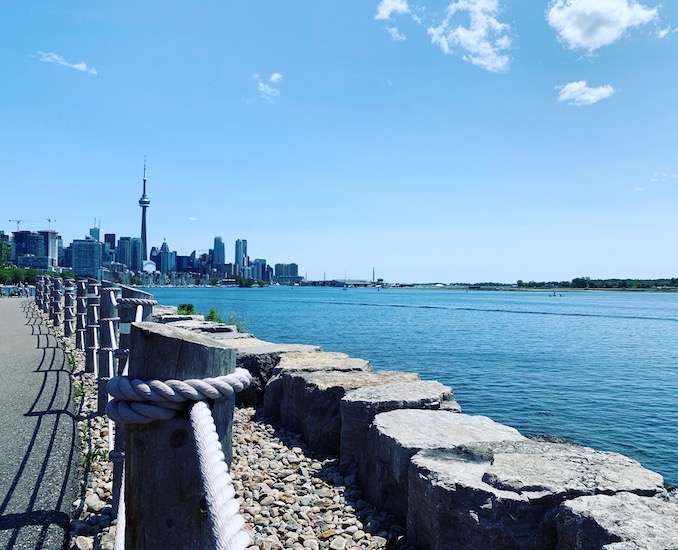
WHERE TO EXPLORE:
Trillium Park: Lakeshore Blvd West and Ontario Place Blvd. The 1.3 kilometre trail is named in honour of Bill Davis, who was the Premier when Ontario Place first opened in 1971. It’s surrounded by thousands of native trees, plants, flowers and beautiful sedimentary rocks and boulders. Inspired by the Ontario landscape itself, the park was designed in consultation with people from across Ontario, including the Mississaugas of the New Credit First Nation. It’s a breathtaking tribute to our province and a gift to the people who love it. Check the programming often. Upcoming events include August 5, (Simcoe Day) attend the Wigwam Chi-Chemung (translated: Big House Canoe)where Elder Duke Redbird will speak about We Are All Treaty People and Eagle Drum Girl performed by the Young People’s Theatre. Have a question about Indigenous history and culture?Drop in and visit with Elder Duke and crew August 3 to 5 between 3pm to 5pm at Ontario Place South Marina.
Crawford Lake Conservation Area: 3115 Conservation Road. Explore the Iroquoian village and learn about local First Nations history. Enjoy a day hike from Crawford Lake through the Nassagaweya Canyon Trail, and journey to Rattlesnake Point. On your way back, from a hike around the lake, detour and take a self-guided Moccasin Walk on the Woodland Trail. Interested in exploring more about the Iroquoian Village? The park offers programming like Longhouse Lore and the Season of the Three Sisters with opportunities to learn about fire-making techniques, and the importance of corn, squash, and beans, to the First Nations. See the site for details.
Royal Botanical Gardens Indigenous Trail: 680 Plains Road, Burlington. Start at the Arboretum near the Nature Interpretive Centre and follow this new trail located in the nature sanctuary. Explore plans used by the Anishinaabe peoples, and their connections to culture, language, ecology and history. Royal Botanical Gardens lays within the traditional territory of both the Anishinaabe and Haudenosaunee Nations. This trail focuses on the story of Anishinaabe plant connections from food, medicinal plants and trade.

FESTIVALS:
Indigenous Arts Festival: happens in June each year at the Fort York National Historic Site. This celebration of traditional and contemporary Indigenous music, dance, theatre, storytelling, film, crafts and culinary of the First Nations, Inuit and Métis peoples of Canada. This year we experienced the Na-Me-Res annual traditional Pow Wow and learned about The Moccasin Identifier Project – an educational project that promotes the ongoing presence of First Nations in cities across Ontario. Live performances that took to the stage this year included the Toronto Métis Jiggers, Toronto’s most recognized Métis dance collective, Brendt Thomas Diabo & The Ramblers, Classic country and Rockabilly band, First Nations DJ Fawn Big Canoe, Juno award-winning group Quantum Tangle, Rap and Hip Hop performer Jah’kota, and Beatrice Deer a Traditional Inuit throat singer.
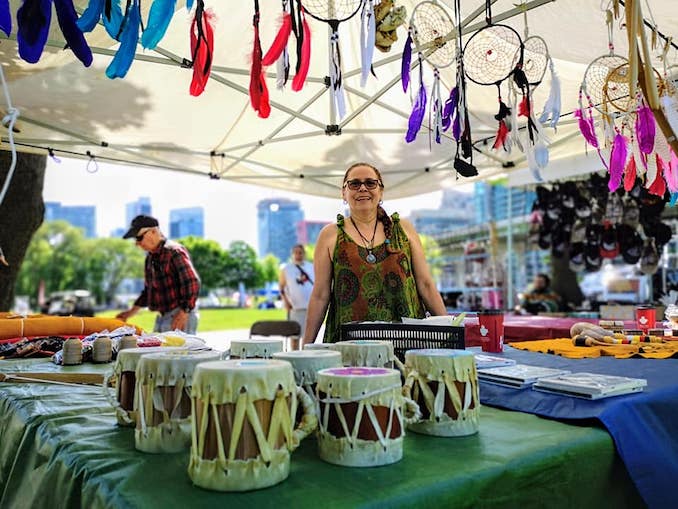
imagineNATIVE Film + Media Arts Festival: October 22 to 27, 2019. The 20th annual festival is the world’s largest of its kind featuring an incredible selection of diverse, contemporary works in films and art created by Indigenous filmmakers and artists from Canada and around the world.



